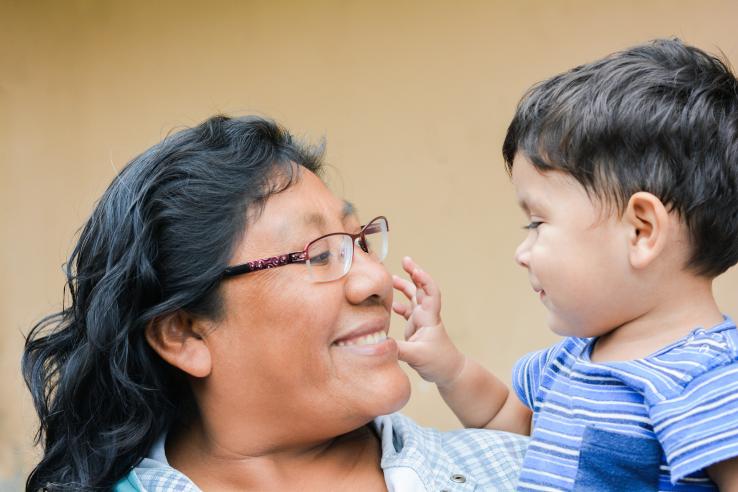
Centering parents and parenting in randomized evaluations of cash transfers to families

The Baby’s First Years evaluation is a J-PAL-supported study evaluating the impact of poverty alleviation on child development and families. In this post, Lisa Gennetian (Duke University) and Sarah Halpern-Meekin (University of Wisconsin-Madison), two researchers involved in Baby’s First Years, discuss the importance of centering parents and their experiences to better understand the impact cash payments have on families.
Nearly all parents want to be good parents; they want their children to have good childhoods, and they want their children to be happy. Regardless of income, wealth, or stress associated with work and poverty, parents will talk about their children with pride, joy, compassion, and a desire to protect them. Parenting is a fundamentally emotional and relational role. However, prevailing theories of parenting and child development generally focus on time and attention but don’t account for the vast and complex role of emotions and experiences. This omission presents dilemmas for guiding analyses of parenting in evaluating interventions. Expanding our understanding of parenting and development by considering these emotions can potentially strengthen the validity and relevance of results of randomized evaluations.
As researchers involved in a randomized evaluation of an unconditional cash transfer to mothers and families residing in or near poverty with young children in the United States, we are paying particular attention to how leading theories help and hinder us from fully assessing the impact of cash transfers to families.
Prevailing parenting theories and their limitations in practice
In the economics literature, theories relevant to parenting include both altruism (care about the child and the child’s future “utility”) and paternalism (parents doing for the child what they see as good for the child). These, in turn, shape the types and quality of the inputs (what economists call the technology or production function) that influences parental investment of financial and time resources in children. Such an approach offers conceptual guidance on how parental resource allocations can affect children’s “human capital”—skills related to education and job preparation.
In the child development literature, theories of parenting center on quality of interactions, including the responsiveness of parents to children’s cues, and certain styles of parenting. Here, emotions may be implicit in affecting interactions and parenting styles (e.g., authoritarian parenting may intersect with being angry or less emotive).
But what if time spent reading a favorite book together at bedtime, for example, was as impactful as a weekly outing to a coffeeshop to get a cake pop, or taking a stroll to the park? Economic theories attune us to the first activity as an investment in children’s human capital. However, they are largely agnostic (or potentially dismissive) as to the “meaning” of the cake pops or the visits to the park as their own independent influence on children’s wellbeing. Existing tools assessing child development attune us to the “conversational turns” between parent and child during these activities and to the presence of an “engaged parenting style” as capturing quality while reading together. But the role of laughter, shared positive experiences and emotions, and the creation of meaningful family rituals and memories from the coffee shop and the park are only interpreted indirectly or implicitly.
These prevailing theoretical perspectives may be limited in offering a robust picture of family life; they also do not map on to what we directly hear from parents.
Expanding beyond these theories
Recently, a mother we interviewed described using some of her cash gift for the month to get holiday decorations. She showed us a photo of her girls, four and nine, each decorating half of the front door. We heard mom’s warm memories and felt her kids’ excitement, as she described how the photo showed “all their personalities that were going on right there; because it was like, ‘This is my side, and this is your side.’ … They are just adorably cute! … They’re good at sharing, but I try to get them, like I try to get them more working together.” This mom had the family put up holiday trimmings little by little across December, boosting her kids’ anticipation and joy as they decorated their way toward Christmas. And it’s not just for her kids, she said, “I’m excited. … God has been good. … I’m just able to see them be happy.” Many of these holiday extras, she explained, she was able to buy with her monthly cash gift.
If we only focus on human capital investments or parent-child interactions, the importance of these positive emotions and this annual family ritual, of the ways that this mom scaffolds her daughters’ relationship with each other by encouraging them to cooperate on projects together, could get missed in direct measurements during planned data collection moments. This might preclude uncovering certain types of effects on parents and children or shape interpretation of findings in limiting ways.
Addressing these blindspots matters for a variety of reasons:
Emotions affect or interact with investments.
Parenting is associated with experiencing a wider range of emotions and more intense positive emotions than when parents are away from their children. And so, parents may be motivated to spend on their children because it makes them feel good. Parenting is an emotional and relational activity, and how we feel about our performance of that role can strike at the heart of how we feel about ourselves. Research has shown that parents with limited incomes feel a strong need not just to cover the basics financially, but also to be able to purchase “extras” for their children. Without more guiding theory, such motivations—outside of the bounds of parental beliefs and knowledge—end up being noise in economic models.
Not all parental investments may fit into conventional mechanisms that have returns to “human capital” development.
News accounts and qualitative interviews with people receiving the expanded 2021 Child Tax Credit attested to the important changes in family life resulting from the additional income. This included, for example, parents with lower incomes being able to enroll their children in extracurricular activities or having more family outings. Unless family outings are categorized as “time spent in enriching activities,” theories of family investment in economics have little to say about the full emotional and relational return to time spent together on family outings. A trip to the movie theater, going to the mall, or even going out of town to visit family can be quantified in dollars and minutes, but their meaning may elevate or dilute those quantifiable metrics.
Emotions affect motivation and decision-making, which can affect investments and parenting behavior.
There are also suggestions in existing research that positive emotions in parents in the short-term may give rise to enhanced cognitive processing, like problem solving, over the longer term.
Applying new, expansive theories to rigorous evaluation
The hypotheses we as researchers develop as we evaluate the wide array of cash transfers families experience—from government sources, like the Child Tax Credit or the Alaska Permanent Fund, as well as from philanthropic sources, like the various unconditional cash gift experiments underway across the country, including our own Baby’s First Years study—must be informed by a broad set of theories. These theories should attend not just to the financial and time investments parents make in their children, but also to the emotional and relational experiences of parenting and family life.
With such an approach, we can better anticipate and understand the trade-offs and decisions parents make about how to spend their money and time. We can also make more informed choices about the outcomes and metrics by which we assess policy or intervention success. Parents care about bedtime stories and cake pops and park visits, and they spend accordingly. Yet, our current research approaches are not designed to capture these “preferences” or “interactions” beyond what is observable or measurable with our current tool set of validated outcomes.
Here are some examples of how to do this:
Go beyond child-specific time to whole-family time.
Current measurement often captures child-related expenditures (clothing, books, toys, enrichment activities) or minutes parents spent on child development activities (e.g., reading together, telling stories). Additional measures could capture family-related experiences and activities (such as the trips to the coffee shop and the park, or a family decorating for the holidays); and, including siblings and whole-family interactions.
Broadly consider types of spending, time, and experiences that may intersect with the design, magnitude, and predictability of cash transfers.
For example, does the periodic versus lump sum form of cash transfers alter the proportion of dollars parents spend on child-related core expenditures, treats (like a take-out meal), or family-related experiences? Do they vary in how they support the quality of children’s home environments or parents’ purchases of childcare, core household expenses, and big-ticket items, like air conditioners or washing machines?
Model how time and money allocations that evoke positive emotions affect short- versus long-term outcomes.
Also, how might these predict outcomes for children and parents during children’s younger years versus their adolescent years?
Measure a wide variety of emotions.
Ameliorating negative outcomes (e.g., avoiding food insecurity or eviction) is important but distinct from promoting positive outcomes (e.g., a child feeling a sense of loving connection with a parent). It is likely possible for an intervention to do one without the other, therefore assessing both are essential to fully evaluating intervention impacts.
Pursuing these insights has important implications for evaluating and measuring the impacts of ongoing and future randomized evaluations of cash transfer programs and policies.
Related Content

Rigorously evaluating cash transfer programs in the United States: Considerations, challenges, and future research questions

Strengthening randomized evaluations with qualitative research: Baby’s First Years household measurement


